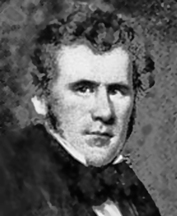Archibald Alexander Ritchie facts for kids
Quick facts for kids
Archibald Alexander Ritchie
|
|
|---|---|
 |
|
| Born | 28 January 1806 |
| Died | 9 July 1856 (aged 50) |
| Nationality | American |
Archibald Alexander Ritchie (born January 28, 1806 – died July 9, 1856) was an American ship captain, a trader who worked with China, and a businessman in California.
Contents
Early Adventures and Family Life
Archibald Alexander Ritchie was born in New Castle, Delaware, on January 28, 1806. His family came from Scotland and Ireland.
When he was just 13 years old, Archibald ran away from home! He joined a ship that was sailing all the way to China. This was a big adventure for a young boy. By the time he was 18, he had already become the captain of a ship called the Treaty.
In 1831, Ritchie married Martha Hamilton in Philadelphia. While he was away on a long trip to bring tea and silk from China, their first child, Eliza, was born in 1832.
In 1838, Ritchie became an agent in Canton (Guangzhou), China, for a company from Philadelphia. His job was to trade things like animal hides, tallow (animal fat), and otter skins from California for goods from China. His wife and children later joined him in Macau, which is near Canton. Several of their children were born there. The family returned to Philadelphia in 1847.
New Opportunities in California
Ritchie traveled to California during the exciting time of the California Gold Rush (1848–1855). He quickly realized that there were many chances to start businesses by supplying the miners who were passing through San Francisco.
In 1850, Ritchie bought two large pieces of land: Rancho Guenoc, which was about 21,200 acres, and Rancho Collayomi, about 8,200 acres. The town of Middletown is located on this land today.
That same year, he also bought the Suisun land grant for a large sum of money. He paid some cash and took out a loan for the rest. Soon after, Captain Robert Henry Waterman, who also traded with China, bought a share of the Suisun property and became Ritchie's business partner.
Ritchie also owned rights to hot springs in the upper Napa Valley. He sold part of this land to Samuel Brannan, who then created the famous resort in what is now Calistoga.
Dealing with Land Challenges
Even though Ritchie bought his land, some people were already living on it without permission. These people were called "squatters." Ritchie had to go to court many times to get them to leave. He noted that some squatters were wealthy people with nice farms.
In 1850, Ritchie bought land in Benicia, hoping it would become the state capital. He built a beautiful house there. But in 1854, around the time his wife and children came to join him, the house burned down. Some believed it was set on fire by squatters who had been forced to leave his land.
The Ritchies then arranged for another house to be built in San Francisco. It was finished just before Ritchie passed away.
Community Involvement and Later Life
Ritchie was an important member of the San Francisco community. He helped organize aid for people affected by the Acapulco Earthquake of 1852.
When a major bank failed in 1855, it caused many businesses in San Francisco to struggle. Ritchie was one of 25 businessmen chosen to help calm the situation and prevent more businesses from failing.
In 1856, Ritchie supported a journalist named John Nugent who was criticizing a group called the Second Vigilance Committee.
Archibald Alexander Ritchie died on July 9, 1856. He was traveling from Sonoma to Napa when he was thrown from his buggy. His death was recorded as being due to a sudden medical event.
Legacy
Archibald Alexander Ritchie was buried in the Yerba Buena Cemetery. His body was later moved to Laurel Hill, and then again to Cypress Lawn Memorial Park in Colma.
It took 14 years for Ritchie's will to be fully settled after his death. His business partner, Robert Henry Waterman, was in charge of his estate.
In 1861, when Lake County was created from part of Napa County, someone was hired to manage Ritchie's Rancho Guenoc and Rancho Collayomi. These land grants were finally approved in 1863 and 1865.
By 1870, Ritchie's family began to divide the Guenoc property into smaller pieces to sell. This helped develop the southern part of Lake County.
Sources

